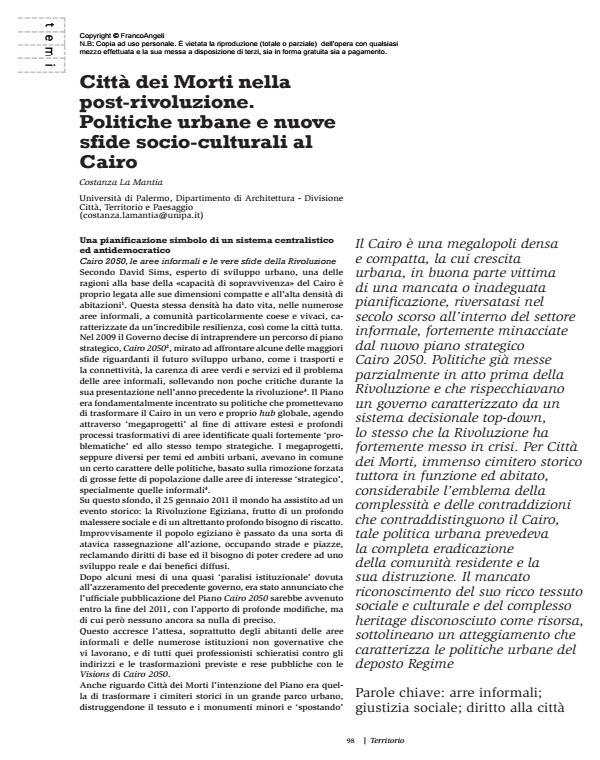Città dei Morti nella post-rivoluzione. Politiche urbane e nuove sfide socio-culturali al Cairo
Titolo Rivista TERRITORIO
Autori/Curatori Costanza La Mantia
Anno di pubblicazione 2012 Fascicolo 2012/61
Lingua Italiano Numero pagine 6 P. 98-103 Dimensione file 1275 KB
DOI 10.3280/TR2012-061017
Il DOI è il codice a barre della proprietà intellettuale: per saperne di più
clicca qui
Qui sotto puoi vedere in anteprima la prima pagina di questo articolo.
Se questo articolo ti interessa, lo puoi acquistare (e scaricare in formato pdf) seguendo le facili indicazioni per acquistare il download credit. Acquista Download Credits per scaricare questo Articolo in formato PDF

FrancoAngeli è membro della Publishers International Linking Association, Inc (PILA)associazione indipendente e non profit per facilitare (attraverso i servizi tecnologici implementati da CrossRef.org) l’accesso degli studiosi ai contenuti digitali nelle pubblicazioni professionali e scientifiche
Cairo is a dense, compact megalopolis with an urban growth, mostly the victim of inadequate or non-existent planning, that spilled out during the last century into the informal sector and is powerfully threatened by the new Cairo 2050 strategic plan. Policies already partially put into action before the revolution reflected a government characterised by a top-down system of decision-making, the same system the evolution strongly placed in jeopardy. For the City of the Dead, an immense historic cemetery, still functioning and still inhabited, and a major symbol of the complexity and contradictions that distinguish Cairo, this urban policy envisaged the complete eradication of the resident community and its destruction. The lack of recognition of its rich social and cultural fabric and the complex heritage unrecognised as a resource, underline an attitude that characterises the urban policies of the deposed Regime.
Parole chiave:Informal rents; social justice; right to a city
Costanza La Mantia, Città dei Morti nella post-rivoluzione. Politiche urbane e nuove sfide socio-culturali al Cairo in "TERRITORIO" 61/2012, pp 98-103, DOI: 10.3280/TR2012-061017